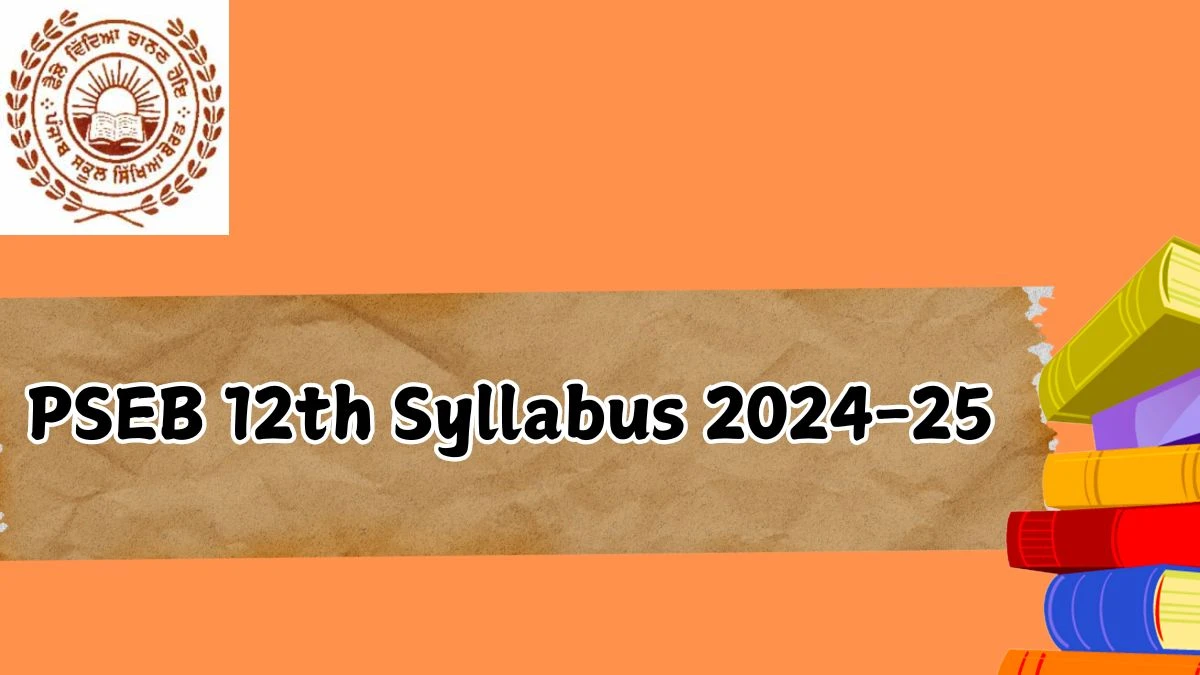- Rojgarlive »
- Education »
- PSEB 12th Syllabus 2024-25 at pseb.ac.in Check and Download Syllabus Here
PSEB 12th Syllabus 2024-25 at pseb.ac.in Check and Download Syllabus Here
by Keerthika
Updated Sep 02, 2024

PSEB 12th Syllabus 2024-25 at pseb.ac.in
The Punjab School Education Board (PSEB), the official education authority of Punjab, has released the revised syllabus for students of all classes, from 1st to 12th standard. We are providing the PSEB Class 12th Syllabus 2025 for students who have just started the academic year 2024-2025 and will be taking their board exams in 2025. You can access subject-wise links to the detailed syllabus, along with PDF download links for each. In addition to the syllabus, students can also find information on the course structure, detailed course content, marking scheme, exam pattern, and more.
Check - PSEB 12th Syllabus 2024-25
MATHS
|
Unit I: Relations & Functions |
|
Chapter 1 Relations and Functions: Types of relations: Reflexive, symmetric, transitive, and equivalence relations. Types of functions: One-to-one and onto functions, composition of functions, and invertible functions |
|
Chapter 2 Inverse Trigonometric Functions: Definition, Range, Domain, Principal value branches. Graphs of inverse trigonometric functions, Properties of inverse trigonometric functions |
|
Unit II: Algebra |
|
Chapter 3 Matrices: Concept, notation, order, equality, types of matrices, zero and identity matrix, transpose of a matrix, symmetric and skew-symmetric matrices. Operation of matrices. Addition and multiplication and multiplication with a scalar. Simple properties of addition, multiplication, and scalar multiplication. Non-commutatively of multiplication of matrices and existence of non-zero matrices whose product is the zero matrices (restrict to square matrices of order 2). Invertible matrices and proof of the uniqueness of inverse, if it exists; (Here all matrices will have real entries). |
|
Chapter 4 Determinants: Determinant of a square matrix (up to 33 matrices), minors, cofactors and applications of determinants in finding the area of a triangle. Adjoint and inverse of a square matrix. Consistency, inconsistency and number of solutions of system of linear equation by examples, solving system of linear equations in two or three variables (having unique solution) using inverse of a matrix. |
|
UNIT III: Calculus |
|
Chapter 5 Continuity and Differentiability: Continuity and Differentiability, derivative of composite functions, chain rule, derivative of inverse trigonometric functions, derivative of implicit function. Concepts of exponential and logarithmic functions. Derivatives of logarithmic and exponential functions. Logarithmic differentiation, derivative of functions expressed in parametric forms. Second order derivatives |
|
Chapter 6 Applications of Derivatives Applications of derivatives: rate of change, increasing/decreasing functions, maxima and minima (first derivative test motivated geometrically and second derivative test given as a provable tool). Simple problems (that illustrate basic principles and understanding of the subject as well as real life situations) |
|
Chapter 7 Integrals: Integration as inverse process of differentiation. Integration of a variety of functions by substitution, by partial fractions and by parts, Evaluation of simple integrals of the following types and problems based on them: Fundamental Theorem of Calculus (without proof). Basic properties of definite integrals and evaluation of definite integrals |
|
Chapter 8 Applications of the Integrals: Applications in finding the area under simple curves, especially lines, circles/parabolas/ellipses (in standard form only). |
|
Chapter 9 Differential Equations: Definition, order and degree, general and particular solutions of a differential equation. Solution of differential equations by method of separation of variables, solutions of homogeneous differential equations of first order and first degree. Solutions of linear differential equation of the type: |
|
Unit IV: Vectors And Three Dimensional Geometry |
|
Chapter 10 Vectors: Vectors and scalars, magnitude and direction of a vector. Direction cosines and direction ratios of vectors. Types of vectors (equal, unit, zero, parallel and collinear vectors), position vector of a point, negative of a vector, components of a vector, addition of vectors, multiplication of a vector by a scalar, position vector of a point dividing a line segment in a given ratio. Definition, Geometrical interpretation, properties and application of scalar (dot) product of vectors, vector (cross) product of vectors. |
|
Chapter 11 Three-dimensional Geometry: Direction cosines and direction ratios of a line joining two points. Cartesian equations and vector equation of a line, skew lines, shortest distance between two lines. Angle between two lines. |
|
Unit V: Linear Programming |
|
Chapter 12 Linear Programming: Introduction related terminology such as constraints, objectives function, optimization, Graphical method of solution for problems in two variables, feasible and infeasible regions (bounded or unbounded) feasible and infeasible solutions, optimal feasible solutions (up to three non-trivial constrains) |
|
Unit VI: Probability |
|
Chapter 13 Probability: Conditional probability, multiplication theorem on probability, independent events; total probability, Baye's theorem |
English
|
Section |
Title |
Author |
|---|---|---|
|
Section A (Lessons for Intensive Study) |
Hassan's Attendance Problem |
Sudha Murthy |
|
|
The March King |
Katherine Little Bakeless |
|
|
Thinking Out of the Box: Lateral Thinking |
|
|
|
On Saying 'Please' |
A. G. Gardiner |
|
|
The Story of My Life |
Helen Keller |
|
|
Two Gentlemen of Verona |
A. J. Cronin |
|
|
In Celebration of Being Alive |
Dr. Christian Barnard |
|
|
Gadari Babas in Kalapani Jail |
Dr. Harish Puri |
|
Section B (Poetry) |
Prayer of the Woods |
|
|
|
On Friendship |
Khalil Gibran |
|
|
The Echoing Green |
William Blake |
|
|
Once upon a Time |
Gabriel Okara |
|
|
The Road Not Taken |
Robert Frost |
|
|
Father Returning Home |
Dilip Chitre |
|
|
On His Blindness |
John Milton |
|
Section C (Lessons for Extensive Study) |
The School for Sympathy |
E. V. Lucas |
|
|
A Chameleon |
Anton Chekhov |
|
|
Bholi |
K. A. Abbas |
|
|
The Gold Frame |
R. K. Laxman |
|
|
The Barber's Trade Union |
Mulk Raj Anand |
|
|
The Bull beneath the Earth |
K. S. Virk |
|
Section D (Grammar and Composition) |
Grammar: Determiners, Non-finites (Infinitives, Gerunds, Participles), Transformation of Sentences, Voice, Narration |
|
|
|
Composition: Précis writing, Letter writing (Official/Business/To Editors), Application, Explaining Newspaper Headline, Email writing |
PSEB 12th Syllabus 2024-25? -FAQ
The PSEB 12th syllabus includes core subjects such as Physics, Chemistry, Biology, Mathematics, English, Computer Science, and other elective subjects like Economics, Business Studies, Political Science, and Physical Education.
Students can download the PSEB 12th syllabus for the 2024-25 academic year from the official PSEB website (www.pseb.ac.in) or through direct links provided by the board for each subject's detailed syllabus.




